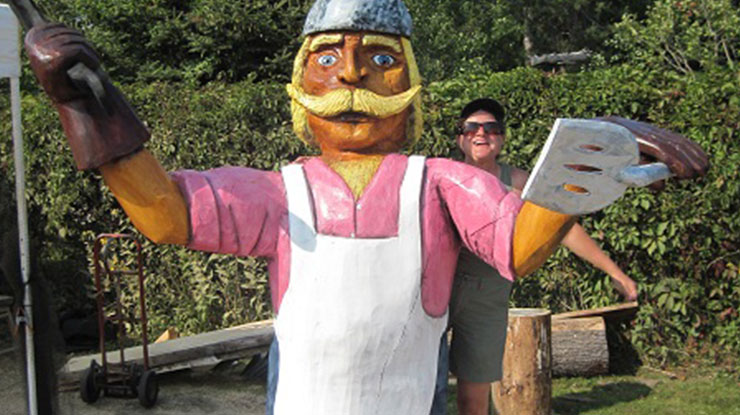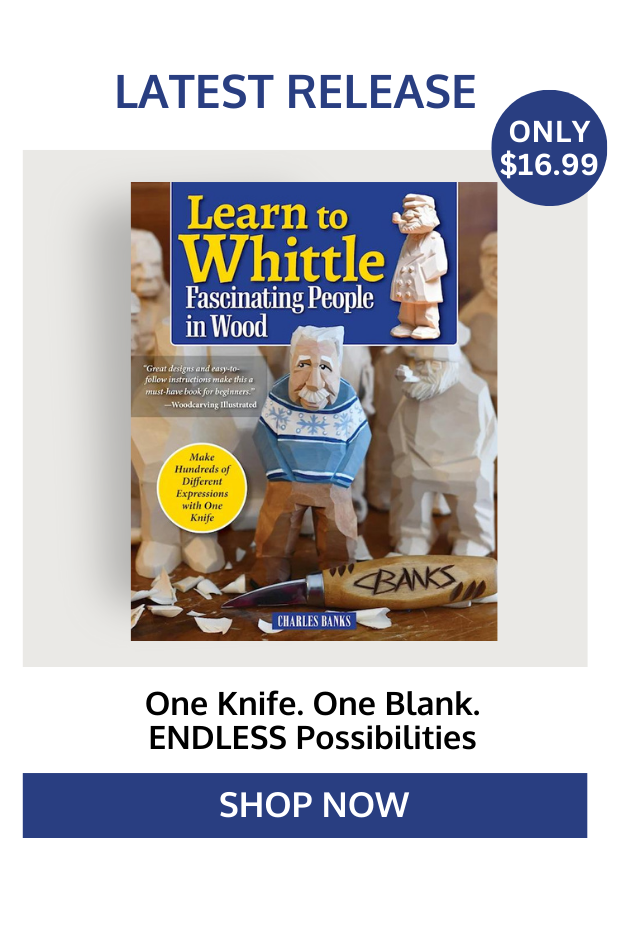Some battle-weary warriors are finding comfort through woodworking
By Dorissa Bolinski
It’s easy to slip into the “zone” while engaged in an interesting project, when fifteen minutes become two hours and the worries of the day fall away. Like all creative pursuits, woodworking can remove us from our daily selves and transport us to a quiet place where the only thing that matters is the task at hand.
The calming effect of creative work has long been studied in the field of art therapy to help people process negative emotions. Activities like woodworking require one to take time and focus while establishing a meditative rhythm. Working this way can reduce stress and promote an easy concentration. Plus, it’s exhilarating to tap into personal creativity and see an idea form from your own handiwork.
In the past few decades, art therapy has become part of the prescription for medical professionals who work with combat-wounded veterans and those experiencing post-traumatic stress disorder (PTSD). Although most art therapy programs focus on artforms like poetry and painting, woodworking is entering the arena as an option. Activities like whittling a piece of wood or quietly sanding a box lid can help divert the mind from the day’s troubles and ease intrusive thoughts. Although there are no medical studies citing the therapeutic benefits of woodworking, it makes sense that some veterans find it helpful, and in some cases, medical professionals are catching on.
While there isn’t an abundance of woodworking veterans’ groups, people involved in this work have seen positive change occur through the hobby. One group is the Purple Heart Project, which provides traditional hand tool classes to combat-wounded veterans. Their goal is to offer solace and community through the joy of woodworking. According to Luther Shealy, Executive Officer of the Purple Heart Project, participant reaction has been profound, and several U.S. and Canadian therapists have inquired about his program or recommended it to their patients.
“We’ve had several folks tell us they were on the verge of suicide, super depressed, or not knowing what to do with themselves. Then being in our workshop changed everything for them,” Luther says.
|
Popular WCI contributors, Gerry Canavan and Gary Fenton, also cite positive experiences with carving classes they taught at Imagination Celebration in Colorado Springs, Colo. for the CACTUS (Creating Art Can Tell Untold Stories) program. A few years ago, their carving group, the Pikes Peak Whittlers, met Robin Dahman, a nurse with a background in physical and cognitive rehabilitation work. Robin was part of the medical team at Fort Carson that facilitates the Intrepid Spirit Center, which helps soldiers with traumatic brain injury and PTSD prepare for civilian life. |
A participant makes progress during a carving class at Imagination Celebration at Colorado Springs, Colo. Photo by Robin Dahman |
With a certification in trauma art, Robin headed up the creative media portion of the Center and started the CACTUS program to provide service members and their families a safe place to participate in creative outlets together like woodcarving. She began working with local artisans like the Pikes Peak Whittlers who shared their skills with participants. Robin says woodcarving is a great creative option for patients since it can inspire concentration, skill building, and confidence.
“You can work alone or in a group setting. There’s the ability to practice emotional regulation skills when you get frustrated. There’s a sense of accomplishment when a project is finished…woodcarving was such a natural fit for our program,” she says.
“Carving requires you to stay in the present and helps filter out extraneous thoughts. I think this has a calming effect, which most carvers experience,” Gerry says. “In a few students, we unlocked a passion and they’re probably still carving today.”
Gary agrees, saying, “Woodcarving can be a middle ground where you have to be aware and careful not to cut yourself, but you also relax. People have a built-in desire to be creative, and woodcarving helps people activate that by seeing a piece of wood turn into something interesting.”
|
One very active group that knows about turning wood into something interesting is the Maine Veteran Woodturners, which strives to provide veterans with a sense of purpose, redirection, and camaraderie. Led by veterans, the group creates custom pens and other turned items that are sold on their website and at craft fairs. According to treasurer Glen Glazier, the group meets once a week with the primary focus of fun, community, and support. He explains that an unfortunate number of veterans can end up with too much time on their hands that might lead to destructive thoughts and habits. The Maine Veteran Woodturners group allows them to put their hands and thoughts toward productive pursuits instead. |
Gene Kelso, Ed Rice, Raymond Wortman, and Thomas Cole Sr. of the Maine Veteran Woodturners collaborate on a project. |
“When you’ve been through some of the stuff we’ve been through, it’s easy to get stuck in your mind. This gives our members a time to get out of that,” he says.
Group member Patrick Linehan believes woodworking as a hobby can tap into a sense of peace that keeps members coming back. “You’re working with your hands, doing a little math, paying attention,” he explains. “This frees up your mind from negative thoughts, which reminds you of what comfort felt like.”
While there are many styles of woodworking, the Purple Heart Project involves the use of only hand tools for a quiet, nonthreatening atmosphere for students who might be put off by loud tools and unpredictable situations. But one former soldier who welcomes the roar of power tools is Anthony Martin, who describes himself as “a guy with a chainsaw trying to unite veterans.”
Gravely injured in Afghanistan in 2010, Anthony spent three years in Madigan Army Medical Center in Tacoma, Wash. During that time, he witnessed friends die in the hospital and eventually attempted suicide himself. Soon after, while still recuperating, he started watching a chainsaw carver’s demonstrations on base. Anthony was hooked and began sneaking out of the hospital to watch the carver whenever possible. His medical team wondered about his new fascination with carving but hoped it would be the diversion he needed to thrive again. So, one day his commander gave him a chainsaw. Anthony started carving while still in a wheelchair and was on his feet with his new hobby after just a month.
|
Anthony now works full-time as a chainsaw carver and has also founded Logs4Heros, which honors service members who lost their lives in the line of duty. Through Logs4Heros, Anthony accepts donated logs that he turns into memorials like Soldier’s Crosses for Gold Star Families. Anthony attributes carving to changing his life for the better by helping him cope with PTSD. “When I carve, I have to control my thoughts and channel them to using a chainsaw or power tools,” he explains. “At the same time, as I work, I have to focus on where I’m cutting a log. So, with each carving I’m controlling my thoughts, including memories from war.” |
Anthony Martin fashions wooden tributes to fellow soldiers with a chainsaw. |
As woodworking and carving become a more common aspect of art therapy for veterans, it’s hoped that additional avenues for participation will open. For now, Gerry suggests that veterans who are interested can look for a local woodcarving group to get involved.
“Group members are usually eager to help beginners in any way needed, and there’s the fantastic bonus of forming friendships. Social media is a great way to connect with locals. Carving shows and local woodworking stores might help you get in touch with people,” he says.
Luther says that a woodworking background isn’t necessary to take up the hobby. Half of the participants in Purple Heart Project’s classes have never been in a woodshop and do just fine. In fact, 10 of his students have translated their skills into professional businesses.
The overwhelming consensus is that new woodworkers and carvers shouldn’t be worried that they don’t have the right talent for this. Gary states, “When you start tapping into a creative hobby such as woodcarving, it will stimulate your inherent creativity and skills will increase.”
As a nurse, Robin wholeheartedly encourages veterans to let go of any apprehensions about their lack of woodworking knowledge. “Anything new is a process, and you have the strength and courage to meet the challenge of learning something new,” she says. “Go for it!”
Although he admits he doesn’t know what made carving click for him, Anthony has regained his life by wielding a chainsaw to cut through negative emotions. “With PTSD, if I’m not challenging my mind, I have anxiety, depression, sleepless nights….so how do I deal with this? I go out and carve something!”
Finding fulfilling outlets to assuage the troubles of the day can be challenging in the best of circumstances. But for those who have faced the demons of war, it can be particularly difficult. It’s heartening to know that many of our veteran heroes have found solace and are enjoying a renewed sense of spirit through woodworking.
“You should see our group when we’re working!” Glen exclaims. “We’re all serious in what we’re
working on, but everyone is happy. There’s not a frown on a face!”
If you are a veteran or know someone who might like to try woodworking as a form of art therapy, contact your local veterans health provider at: va.gov/directory/guide/allstate.asp.
For More Information
https://www.rehab.va.gov/PROSTHETICS/rectherapy/Creative_Arts_Therapies.asp
https://www.thepurpleheartproject.org
https://www.pikespeakwhittlers.com
https://www.facebook.com/Logs4Heroes/
https://maineveteranwoodturners.org
 |
Get the Latest Issue! Purchase the IssueFor more articles like this, subscribe to Woodcarving Illustrated magazine. Magazine SubscriptionPlus! Get digital mini magazines in your e-mail between printed issues.
|











